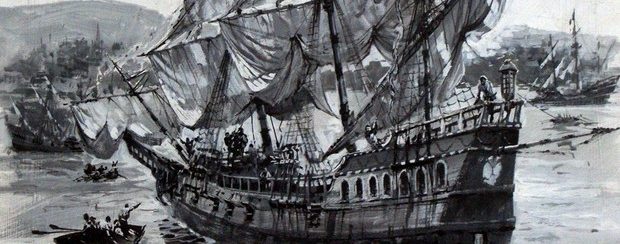Source:ABC
In 1595, the English corsair swooped on the city with the aim of plundering the Spaniards; he was scalded.
The other day I was, how naive me, browsing through a well-known series platform (let’s call it ‘N’, to avoid conflicts) when I came across one of those documentaries that mix history with a dash of drama. Pirates, they promised; the reality behind the myth. And what better lure to give them a ‘click’. Unfortunately, the illusion vanished as a voice-over attributed part of the attacks by British corsairs to the dishonest action (so they said) of Spanish coastguard vessels. It seemed, black legend notwithstanding, that those satans on the waters mercilessly assaulted the poor British after the end of the Anglo-Spanish war and that they responded as a mere defence.
We cannot deny, as Agustín Rodríguez demonstrated in one of his latest books (‘Corsarios españoles’, published by Edaf), that the Spanish Empire also had its privateers. However, it’s a bit of a shock that the nation that handed out privateer’s licences everywhere to every Hawkins they had should receive a facelift of such calibre. Becuase, it is not a question of seeing the speck in someone else’s eye, but the reality is that Her Gracious Majesty boasted of having bandits of the prestige of Francis Drake in her ranks. A man of whom we know many of his glories, but few of his defeats.
So allow me to review today one of the less popular slaps on the neck that our Empire gave this fellow when, on a voyage against Spanish possessions in the Caribbean, he swooped down on Las Palmas with the aim of filling his ships with provisions. For, although this episode does not appear in the series, the defenders of the square defeated him and forced him to flee, full speed ahead and under full sail, after a battle that seemed clearly lost. I would only add, by the way, that this was the expedition on which the corsair contracted dysentery, an illness that cost him his life shortly afterwards. As we know, greed is a bad adviser.
Last expedition
But let’s take it one step at a time, as the story is a complicated one. Agustín Rodríguez narrates in the incombustible ‘Victorias por mar de los españoles’ that, back in the nineties of the 16th century, the good Drake was not at one of the most buoyant moments of his career. In fact, the setback he had suffered in the ‘English Invincible’ expedition – which crashed against our northern defences – had caused him to fall out of favour with Elizabeth I. And the truth is that it was no wonder, because that debacle was compounded by the loss of the galleon ‘Revenge’ (the corsair’s flagship) in the Azores Islands. The successes, which are sometimes like beer foam…
Relegated “to land posts”, according to the Spanish historian, a Drake desperate to regain importance at court offered his monarch a definitive plan: to lead an expedition against the Spanish Caribbean, establish a base of operations in Panama and, from there, put the Empire’s entire trade at risk with his ships. He convinced His Gracious Majesty, but only in part. “Distrusting his experience in leading large expeditions, he made it a condition that he should share command with John Hawkins, reputed as a navigator and even more so as the organiser of the Royal Navy“, the author reveals in his book. And, as if that were not enough, he imposed one of his enemies, Sir Thomas Baskerville, as commanding officer of the land forces.
There was little left for him to do but jump through that hoop and the many others that the Queen might make him jump through. In any case, good company and royal approval allowed him, as he himself told his people, to go to the Caribbean “not as a thief by night, but as a general by day, with a pompous disembarkation, to whom the Spaniards were to offer their surrender, acknowledging him as their lord, and asking for the mercy of their lives”. Good old Drake was not too humble, for he also added that, after the deeds he planned to undertake on the other side of the Atlantic, “in the Court Houses a throne should be erected and acts of sovereignty performed” in his honour.
At least he had the armaments to feel confident. Not in vain did he have six royal galleons (the most modern in the islands), some twenty vessels of different types, 1,500 sailors and 3,000 infantrymen. Something “modest for Europe”, according to Rodríguez, but imperial for fighting on the other side of the water. In any case, it was clear from the first weighing of anchor that it would be an operation led by three heads. And if not, when the privateer had the idea of assaulting the Canary Islands in order to stock up on supplies before the voyage (in fact, they were short of food even before setting sail), he had to convince his companions to undertake the operation.
“Drake proposed attacking the Canary Islands and thus obtaining the necessary supplies, while achieving an easy victory that would boost the morale of the crews. Hawkins was opposed, claiming that time would be lost and, above all, the surprise factor, but given Baskerville’s assurances that his troops would achieve victory in a short time, it was decided to attack Las Palmas”, adds the Spanish author. They convinced themselves, poor dupes, that in less than four hours they would have arrived, landed, taken Las Palmas, plundered like rats and returned to their ships. Little did they know what awaited them.
Battle of Las Palmas
Cesáreo Fernández Duro, a distinguished historian, sailor and obligatory source for any self-respecting lecturer, offers some details of the battle in his extensive ‘Historia de la Armada Española desde la unión de los reinos de Castilla y Aragón’ (History of the Spanish Armada since the union of the kingdoms of Castile and Aragon). The nineteenth-century author recounts that the expedition left Plymouth on 7 September 1595 and that, a few weeks later, they set sail for the Canary Islands. Undaunted, confident and haughty. Very typical of the English of the time. The expert noted: “Superb human presumption, from Xerxes to the present day, so often disillusioned“. 6 October was the day on which our people, a little piece of the Spanish Empire, glimpsed what was coming. This is how Duro himself described it:
“It was 6 October when 28 ships were sighted from the city of Las Palmas, in Gran Canaria, in a marked gesture of hostility. Fifteen were positioned in front of the castle of Santa Catalina; the rest […] the fort of Santa Ana.”
The small city could barely muster, in Rodríguez’s words, a thousand defenders. A derisory figure for the whirlwind that was coming upon them. And, as if that were not enough, most of them were inexperienced militiamen armed in a more than precarious manner. But hey, there was that sacred duty to resist. Or the courage to send the privateer back for five o’clock tea. Duro points out that the first thing the ships did was to beat fervently at the fort of Santa Ana in an attempt to protect “the landings of the people, started with 47 large boats”. The Spanish historian, for his part, reduces the number of these ships to 27.
What they both agree on is that a surprise awaited them on land in the form of red-and-yellow troops. This is how Duro explains it:
“To prevent it [the disembarkation] the men-at-arms, with the exception of the Bishop and the clergy, went with the governor Alonso de Alvarado. They handled six small field pieces, with which they battered four of the ships.”
It seems that the defence surprised the English and his henchmen. It did not diminish their haughtiness, though. Baskerville half-sheathed his sword and confirmed that four hours was too little, but that he would have no problem in conquering the city if he was given four days. Drake was in no mood for gambling, but he needed a watering hole urgently, so he decided to abandon his desire to conquer the city, but to land a small force in Arguineguin Bay to collect some of the liquid element and get the hell out before he got a slap in the face. What could go wrong? A lot of things…
Unfortunately (for the Royal Navy) this mission ended as horribly as the previous one. Not even all the corsair’s wiles were enough to stop the brave response of a patrol of horsemen on the coast who, on noticing that the British were coming ashore, responded with a salute befitting the red-and-yellow hospitality. “They surprised the soldiers coming from one boat, killing eight of their crew and capturing two, whereupon the mission of the expedition was discovered and light warning ships were quickly sent to Spain and the Indies. For its part, and once again frustrated, the English squadron provided itself with water and firewood as best it could in uninhabited places on La Gomera, after which, on 4 October, it left for Puerto Rico”, Rodríguez concludes.
The victory won at the Battle of Las Palmas, a battle forgotten by the series of online platforms, was twofold. On the one hand, Drake’s expedition was given a lesson. But also, as Duro explains in his book, it allowed the Spanish Empire to warn its Atlantic possessions of what was coming.
“The most important thing about the action, celebrated as a victory that freed the islands from the threatening calamity, was the opportunity it offered to send advance warning to the West Indies, and from there to the whole of Tierra Firme, of the proximity of the enemy fleet that had been repulsed; a warning that was doubly useful for the prevention and morale of the Indian peoples, especially that of San Juan de Puerto Rico, the custodian at the time of a remarkable treasure.”
The treasure, as they say, is another story…
Share this article
On This Day
No Events
History of Spain
26 August 2020
27 January 2021
Communism: Now and Then
23 December 2022
28 July 2021







